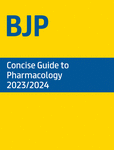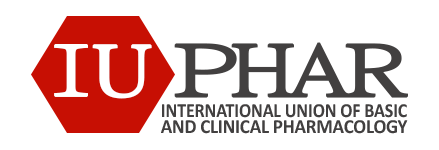
GtoPdb is requesting financial support from commercial users. Please see our sustainability page for more information.
The IUPHAR/BPS Guide to PHARMACOLOGY
The International Union of Basic and Clinical Pharmacology (IUPHAR) / British Pharmacological Society (BPS) Guide to PHARMACOLOGY is an expert-curated resource of ligand-activity-target relationships, the majority of which come from high-quality pharmacological and medicinal chemistry literature. It is intended as a “one-stop shop” portal to pharmacological information and its main aim is to provide a searchable database with quantitative information on drug targets and the prescription medicines and experimental drugs that act on them. In future versions we plan to add resources for education and training in pharmacological principles and techniques along with research guidelines and overviews of key topics. We hope that the IUPHAR/BPS Guide to PHARMACOLOGY (abbreviated as GtoPdb) will be useful for researchers and students in pharmacology and drug discovery and provide the general public with accurate information on the basic science underlying drug action.
The information in the database is presented at two levels: the initial view or landing pages for each target family provide expert-curated overviews of the key properties and selective ligands and tool compounds available. For selected targets more detailed introductory chapters for each family are available along with curated information on the pharmacological, physiological, structural, genetic and pathophysiogical properties of each target. The database is enhanced with hyperlinks to additional information in other databases including Ensembl, UniProt, PubChem, ChEMBL and DrugBank, as well as curated chemical information and literature citations in PubMed.
The database will continue to expanded to include major areas of interest to pharmacology. One of our main goals is to provide information on all the targets of currently licensed drugs as well as other potential targets of interest.
The current version of the database is based on information contained in:
-
Data originally published in the 5th (2011) edition of the BPS Guide to Receptors and Channels (GRAC) (1), which provided a succinct overview of the key properties of over 1600 established or potential pharmacological targets. This has now been replaced by the Concise Guide to PHARMACOLOGY (CGTP), which was first published in 2013 and is updated biennially. This is published in the British Journal of Pharmacology and is created from a snapshot of the database summary pages (2).

(1) SPH Alexander, A Mathie, JA Peters. (2011) Guide to Receptors and Channels (GRAC), 5th edition. Br J Pharmacol., 164 (Suppl. s1), 1-324. [Table of Contents]
(2) Alexander SP, Kelly E, Mathie A, Peters JA, Veale EL, Armstrong JF, Faccenda E, Harding SD, Pawson AJ, Southan C, Buneman OP, Cidlowski JA, Christopoulos A, Davenport AP, Fabbro D, Spedding M, Striessnig J, Davies JA et al. (2021) The Concise Guide to PHARMACOLOGY 2021/22. Br J Pharmacol. 178 Issue S1: S1-S513. [Table of Contents]
-
The IUPHAR database (IUPHAR-DB), which provides in-depth coverage of the properties of G protein-coupled receptors (GPCRs), ion channels, nuclear receptors, selected enzymes and their ligands, intensively curated and peer-reviewed, with the chemical substances rigorously defined with molecular descriptors. All the data contained within IUPHAR-DB are now available via the Guide to PHARMACOLOGY website. (The original website was at https://www.iuphar-db.org but this is no longer maintained and we plan to eventually retire the URL.)

The GtoPdb Curation Team
The IUPHAR/BPS Guide to PHARMACOLOGY is developed within the Centre for Discovery Brain Sciences at the University of Edinburgh, led by Prof. Jamie Davies who took over the role from Prof. Tony Harmar upon his retirement from the University in 2014. The team comprises the developers, Dr. Simon Harding and Dr. Liangcui Chu, and the curators, Dr. Jane Armstrong, Dr. Elena Faccenda and Dr. Christopher Southan.
We would like to recognise and thank previous curatorial and database staff: Helen Benson, Chido Mpamhanga, Adam Pawson, Sam Ireland, Joanna Sharman and Tony Harmar.
Please contact us with all enquiries, comments, error reports: Email us
For information on how to cite the data please visit this page.
About IUPHAR
Founded in 1959 as a section of the International Union of Physiological Sciences, the International Union of Basic and Clinical Pharmacology (IUPHAR) has been independent since 1966. IUPHAR is a member of the International Council for Science (ICSU) and participates in the work of its scientific committees. It receives international recognition, particularly by the United Nations Educational, Scientific and Cultural Organization (UNESCO).
The Nomenclature and Standards Committee of the International Union of Basic and Clinical Pharmacology (NC-IUPHAR), founded in 1987, is chaired since 2015 by Steve Alexander (UK). It has the mission of issuing guidelines for classification of drug targets, addressing the main issues in pharmacology today, classifying the major receptor, ion channel, enzymes and transporter systems, facilitating the interface between the discovery of new sequences from the Human Genome Project and the designation of the derived proteins as functional drug targets and maintaining a website (the IUPHAR/BPS Guide to PHARMACOLOGY portal) with access to data on all known human pharmacological targets, freely available to all scientists, anywhere in the world. NC-IUPHAR publishes articles on target nomenclature and guidelines for terminology in Pharmacological Reviews, in collaboration with ASPET, and also publishes reviews and editorials on other topics in the British Journal of Pharmacology.
Click here for the full publication list.
About the BPS
The British Pharmacological Society (BPS) is a charity with a mission to promote and advance the whole spectrum of pharmacology. Founded in 1931, the Society is now a global community at the heart of pharmacology, with over 3,500 members from more than 60 countries worldwide.
The Society leads the way in the research and application of pharmacology around the world through scientific meetings, educational materials and peer-reviewed journals: the British Journal of Clinical Pharmacology, the British Journal of Pharmacology and Pharmacology Research & Perspectives, an open access journal published jointly with ASPET and Wiley.
The Concise Guide to PHARMACOLOGY (formerly The Guide to Receptors and Channels (GRAC)) is published in the British Journal of Pharmacology as a publication snapshot created from the IUPHAR/BPS Guide to PHARMACOLOGY summary pages, with essential information on drug targets. This data is provided succinctly, so that a newcomer to a particular target group can identify the main elements "at a glance". BPS is proud of the role this popular resource will play alongside the database of our project partners, the International Union of Basic and Clinical Pharmacology (IUPHAR).
The Society welcomes applications for membership from all those involved in pharmacology or related disciplines, and offers complimentary or reduced rates at scientific meetings, complimentary access to its journals and a range of bursaries, travel grants and awards to encourage our members in their scientific careers.
License
The Guide to PHARMACOLOGY database is licensed under the Open Data Commons Open Database License (ODbL).
 Its contents are licensed under a Creative Commons Attribution-ShareAlike 4.0 International License
Its contents are licensed under a Creative Commons Attribution-ShareAlike 4.0 International License
Disclaimer
IUPHAR and the BPS have endeavored to ensure the scientific accuracy of all entries to this database, but cannot take any responsibility for errors. To confirm the accuracy of any database entry, users must refer to original publications cited.
The content of this site is intended for educational and scientific research purposes only and not as a source of medical advice or consultation.







